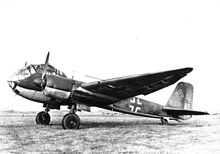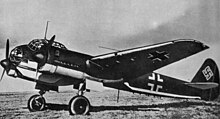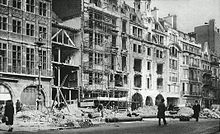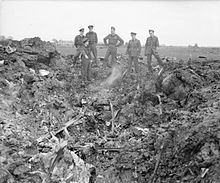Capricorn company
| date | January 21, 1944 to May 29, 1944 |
|---|---|
| place | United Kingdom |
| output | Demolition after heavy losses by the Luftwaffe |
| Parties to the conflict | |
|---|---|
| Commander | |
|
Roderic Hill |
|
| Troop strength | |
| 547 aircraft (as of January 20, 1944) |
around 500 night fighter flak forces |
| losses | |
|
329 aircraft total loss |
1 aircraft lost in combat |
The company Capricorn (also Operation Capricorn ) was a series of bomb attacks by the German Luftwaffe on London and other British cities in World War II .
Starting position
After the end of the Battle of Britain and before the attack on the Soviet Union began on June 22, 1941, most of the fighter units were relocated to the east. The remaining combat squadrons in the west, which were grouped under Luftflotte 3 (Generalfeldmarschall Hugo Sperrle ), had an actual strength of 223 combat aircraft on July 26, 1941, of which 87 were operational. Under these conditions, a continuation of the heavy air raids of the previous year was out of the question. The Air Force focused on attacking British ships and laying sea mines in British waters. In addition, there were disturbance attacks in the dark with a few aircraft on the island itself.
As of April 30, 1942, there were 139 fighter aircraft available, 70 of which were operational. A year later, on March 31, 1943, the number of combat aircraft in existence had risen to 279, of which 155 were operational.
Apart from three night raids on London , the Luftwaffe only flew minor attacks on English port cities in 1943. 2298 tons of bombs were dropped. In view of the much larger Allied attacks on Germany, the Luftwaffe made efforts to increase the number of combat aircraft and to intensify the attacks on England.
preparation




In the summer of 1943 Major General Dietrich Peltz became the commanding general of the IX. Air Corps appointed. In this air corps, which was subordinate to Luftflotte 3, all forces in the fight against England were bundled and a new air offensive was prepared. In doing so, Peltz was faced with great difficulties. Due to the improved British night hunting and anti-aircraft guns in 1943, only around 20 percent of the bombs fell on average in the target area during a German night attack. 5.6 percent of the attacking aircraft were lost. The individual crews dropped out after 13 to 18 missions and could hardly gain experience.
In preparation, the Luftwaffe relocated Kampfgeschwader 30 , 54 and I. Gruppe of Kampfgeschwader 76 (I./76) from the Mediterranean area and re-established I./KG 100 from the eastern front in the west with He 177. In addition, there were already existing Combat Squadrons 2 , 6 and I./SKG 10 . The I./KG 66 , a newly established association, was specially trained for target setting / target marking ( scout tasks ).
From August 17 to October 7, 1943, the Luftwaffe did not launch any attacks on England. During this time, the crews were trained intensively and the company was prepared. For this purpose, the air force command staff worked on the target documents from 1940/41. Until the end of the year, since casualties were to be avoided, the squadrons flew only a few attacks, mainly for training purposes. Everything was geared towards January 21, 1944, the beginning of the Steinbock company.
In a telex dated December 30, 1943, the Commander-in-Chief of the Air Force Reichsmarschall Hermann Göring summarized the reasons and goals of the company.
“In retaliation against the increasing number of terrorist attacks by the enemy, I decided to intensify the aerial warfare against the English island by means of combined strikes against cities (especially industrial targets and port centers). All associations are under the unified leadership of Commanding General IX. Fliegerkorps and using all the experience gained in the last few months in the battle against England, combined against priority targets. In general, 70 percent of the payload must be used to carry incendiary bombs in all attacks. The destruction of the English cities is to be striven for by fire, and it is better to completely destroy a medium-sized city than to partially destroy a larger city. "
On January 20, 1944, the IX. Fliegerkorps has the following associations in its ranks, which were intended for the Steinbock company:
| Associations | Planes | Aircraft types | berth | ||
| Should | Is | EB | |||
| Rod / KG 2 | 4th | 3 | 3 | Thu 217K-1 | Soesterberg ( location ) |
| I./KG 2 | 37 | 35 | 35 | Thu 217M-1 | Eindhoven ( location ) |
| II./KG 2 | 37 | 35 | 31 | Ju 188E-1 | Münster-Handorf ( location ) |
| III./KG 2 | 37 | 38 | 36 | Do 217K-1, Do 217M-1, Do 217E-4 | Gilze Rijen ( location ) |
| V./KG 2 | 37 | 27 | 25th | Me 410A-1 | Athies ( location ) |
| Rod / KG 6 | 4th | 3 | 3 | Ju 88A-14 , Ju 88S-1 | Brussels-Melsbroeck ( location ) |
| I./KG 6 | 37 | 41 | 41 | Ju 188E-1 | Chièvres ( location ) |
| II./KG 6 | 37 | 39 | 39 | Ju 88A-4, Ju 88A-14 | Le Coulot ( location ) |
| III./KG 6 | 37 | 41 | 37 | Ju 88A-4, Ju 88A-14 | Brussels-Melsbroeck |
| Bar / KG 30 | 4th | 1 | 1 | Ju 88A-4 | Eindhoven |
| I./KG 30 | 37 | 35 | 29 | Ju 88A-4 | Eindhoven |
| II. KG / 30 | 37 | 36 | 31 | Ju 88A-4 | St. Trond ( location ) |
| 1./KG 40 | 9 | 9 | 5 | He 177A-3 | Châteaudun ( location ) |
| Bar / KG 54 | 4th | 3 | 3 | Ju 88A-4, Ju 88D-1 | Marx ( location ) |
| I./KG 54 | 37 | 36 | 25th | Ju 88A-4 | Wittmund ( location ) |
| II./KG 54 | 37 | 33 | 33 | Ju 88A-4 | Marx |
| I./KG 66 | 37 | 43 | 23 | Do 217E-4, Do 217M-1, He 111H-6 , Ju 88S-1, Ju 188E-1 | Montdidier ( location ) |
| 4./KG 66 | 12 | 0 | 0 | Ju 188E-1 | Vannes ( location ) |
| I./KG 76 | 37 | 33 | 31 | Ju 88A-4 | Laon-Couvron ( location ) |
| I./KG 100 | 21st | 31 | 27 | He 177A-3, He 111H-11 | Châteaudun |
| I./SKG 10 | 42 | 25th | 20th | Fw 190A-5 , Fw 190G-3 | Rosières-en-Santerre ( location ) |
| All in all | 581 | 547 | 478 | ||
Remarks
- ↑ Meaning of the abbreviations, see Organization of Squadrons
- ↑ shortly before the start of the attack, some units moved to so-called advanced operational airfields that were closer to the operational area.
- ↑ Target strength according to the war equipment certificate
- ↑ Actual strength (the aircraft actually present in the unit)
- ↑ Ready for use (actual strength minus aircraft not ready for use)
- In February 1944 the staff and I./KG 51 , who were in Germany for refreshment, were assigned to the IX. Subordinate to the Air Corps. The V./KG 2 was renamed II./KG 52. The rod chain, the 1. and 2./KG 2 converted to Junkers Ju 188.
- In March 1944, the III./KG 30 and the III./KG 54 came to the front, but the II./KG 54 moved to Ingolstadt to refresh . The II. And III./KG 6 as well as the III./KG 30 had to be handed over to the Air Force Command Southeast in Hungary. The 3./KG 2 now also upgraded to Junkers Ju 188.
- In April 1944, individual crews of I./KG 2 returned with their new Junkers Ju 188.
- In May 1944, I./KG 2 and I./KG 6 returned. For this, the badly damaged III./KG 6, I./KG 54 and I./KG 100 had to be returned to the home for refreshment. III./KG 30 was dissolved.
course

The Steinbock company began on the night of January 21-22, 1944. A total of 447 aircraft were to attack London ( Lage ) in two waves five to six hours apart . However, only about half of the bombs dropped fell on mainland England, 32 tons of which fell on the British capital. The main reason for this was that the air force was unable to find the target of the attack safely due to an incorrect radio navigation process. In addition, the scouts of I./KG 66 were too weak. On January 29, 1944, the Luftwaffe flew the second attack on London with 285 fighter planes, which was also a failure. 57 aircraft (7.8 percent) were lost in these two attacks. A total of 101 crews had to prematurely break off the enemy flight due to technical faults. In particular, the only four-engine aircraft, the still immature Heinkel He 177, had a failure rate of 50 percent. The Focke-Wulf Fw 190 of I./SKG 10 attacked targets as fighter bombers (Jabo) during the day. Overall, they had a higher accuracy and a lower loss rate, but achieved little due to their small number.
In February 1944 the IX. Fliegerkorps carried out another six night raids on London. The strengths of the attacking aircraft ranged between 230 and 170 with a decreasing tendency. The loss rate was only 5.2 percent (72 aircraft) and around 50 percent of the bombs hit the city of London.
In March 1944 another four attacks were carried out on London and, for the first time, one each on Hull ( Lage ) and Bristol ( Lage ). The number of attack aircraft continued to decrease and was between 187 and 75. The loss rate also rose again to 8.3 percent (75 aircraft). The hit rate was around 50 percent. The attacks on Hull and Bristol were total failures as the crews could not find their targets.
April then brought the highest losses to date in eight attacks with 8.7 percent (75 aircraft). Only between 60 and 193 aircraft took part in attacks on London, Hull, Bristol, Portsmouth (4 ×) ( location ) and Plymouth ( location ).
In view of the imminent Allied invasion of Western Europe, the embarkation ports of the invasion fleet moved to the fore in May. Goals were on 14./15. May with 91 aircraft Bristol, on 15./16. May (106 aircraft) and 22./23. May (104 aircraft) Portsmouth, 27/28 May with 61 aircraft Weymouth ( Lage ), on 28/29. May with 65 planes Torquay ( Lage ) and on 29./30. May with 51 aircraft Falmouth ( location ). No ships were sunk in any of the night raids. After these six attacks in May with a loss rate of ten percent (50 aircraft), Capricorn ended on May 29, 1944.
losses
The Luftwaffe lost 329 aircraft as a total loss during the 28 major attacks within five months. Around 1,500 people died in the attacked cities.
Result
The too few and mostly poorly trained aircraft crews often did not find their targets, had to break off the attack prematurely due to technical problems or were shot down. The average monthly loss rates were exorbitantly high, so that an aircraft crew could hardly gain experience before they dropped out.
What the British referred to as Baby Blitz (in reference to The Blitz ) was a complete failure from a military perspective.
literature
- Wolfgang Dierich: The air force associations 1935-1945 . Outlines and short chronicles, a documentation. Ed .: Wolfgang Dierich. Verlag Heinz Nickel , Zweibrücken 1993, ISBN 3-925480-15-3 (703 pages).
- Ulf Balke: The Air War in Europe 1939–1941 . Bechtermünz Verlag, Augsburg 1998, ISBN 3-86047-591-6 (1057 pages).
- Horst Boog : The German Reich and the Second World War , Volume 7, dva , ISBN 3-421-05507-6 .
- Franz Kurowski : The aerial war over Germany . Neuer Kaiser Verlag, Klagenfurt 1993, ISBN 3-7043-4061-8 .
- Ron Mackay: The Last Blitz: Operation Steinbock, the Luftwaffe's Last Blitz on Britain - January to May 1944 , Red Kite 2011, ISBN 978-0-9554735-8-6 .
Individual evidence
- ↑ a b c d Ron Mackay, pp. 427-430.
- ↑ Ulf Balke, p. 387.
- ↑ Ulf Balke, p. 388.
- ↑ Ulf Balke, p. 389.
- ↑ Horst Boog, p. 369.
- ↑ Wolfgang Dierich, p. 131.
- ↑ Horst Boog, pp. 375-376.
- ↑ Ulf Balke, p. 390.
- ↑ Ulf Balke, p. 300.
- ↑ Ulf Balke, p. 314.
- ↑ Ulf Balke, p. 326.
- ↑ Ulf Balke, p. 336.
- ↑ Horst Boog, pp. 377-379.
- ↑ a b c d e Horst Boog, p. 379.
- ↑ Jürgen Rohwer , Gerhard Hümmelchen : Chronicle of the Sea War 1939–1945, May 1944. Retrieved January 15, 2017 .


